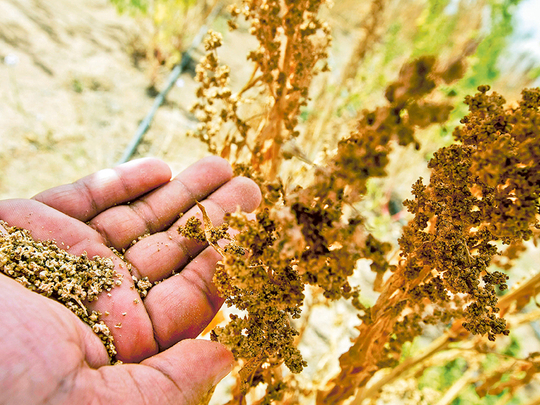
Dubai: What can you grow in a land of scorching summer, poor soil, and scarce water? One answer, as the UAE’s climate change ministry claims, is quinoa.
Both rich in nutrients and able to grow in harsh, arid climates, officials believe that quinoa could be commercially viable within five years.
“Currently, it looks like there’s really good potential … within the next five years to have the crop on the ground,” said Majid Sultan Al Qasimi, a director at the Ministry of Climate Change and Environment.
The grain, which contains more protein than rice and wheat, and nutrients including essential amino acids, fibre, minerals and vitamins, is sometimes referred to as a ‘superfood’.
In the UAE, which produces little of its own food, officials believe the crop could help the nation’s food security.
In 2013, the UAE’s climate change ministry — then known as the environment ministry — first began growing quinoa on home soil.
Several months later, the experiment yielded a crop of 4.5 tonnes — roughly enough to give 75,000 people a small, salad-topping sized portion.
But there’s work left to do — such as working with farmers long used to growing date palms and vegetables.
“For us, what is important is to get the buy-in of the farmer,” Al Qasimi told Gulf News on the sidelines of a Dubai conference dedicated to the crop.
“We’re not here to persuade them and [then] them reluctantly trying. What we’re trying to do here is educate the farmer [and] show them the potential of the crop.”
Quinoa is known for its ability to grow in a wide variety of climates, and can withstand a wide range of daily temperatures — from 0 degree Celsius up to 30C. Its tolerance to salty water makes it suitable for growing in the UAE, which has to desalinate most of its water.
Quinoa’s versatility and rising demand have led many countries to grow the crop. In Pakistan, traders claim that due to cheaper labour and logistics, producing the crop costs half as much as in South America.
Quinoa quandary
The push towards growing Quinoa in the UAE has been a decade in the making. Since 2006, experts at the Dubai-based International Centre for Biosaline Agriculture has been growing and studying quinoa in the country.
Getting locals to want to eat Quinoa is another challenge — but a necessary one in an era of soaring diabetes rates and medical costs, according to Ismahane Elouafi, the centre’s director-general.
“If I go right now to any supermarket, the quinoa is there, and it is sold, so there is a market [for it],” said the Moroccan-Canadian scientist.
“But my feeling is that it’s mostly for the expats. So what you need to do is really bring the locals to be interested in quinoa.”
What is quinoa?
Once the humble staple of poor South American farmers, Quinoa has become a hit with wealthy Western dieters and health-food fanatics who revere its high protein, zero-gluten properties.
The beige-coloured grain’s surging popularity as both a ‘superfood’ and sustainable crop led the United Nations to declare 2013 as the ‘International Year of Quinoa.’
Around the same time, the grain started to crop up in salad bars and cafés across the West. By 2015, even fast-food stalwart McDonald’s started to include Quinoa on some menus.
UAE officials are interested in Quinoa due to its ability to grow in high heat and arid soil. It also requires little water to grow — and can adapt to very salty water.












